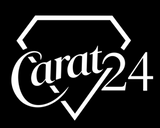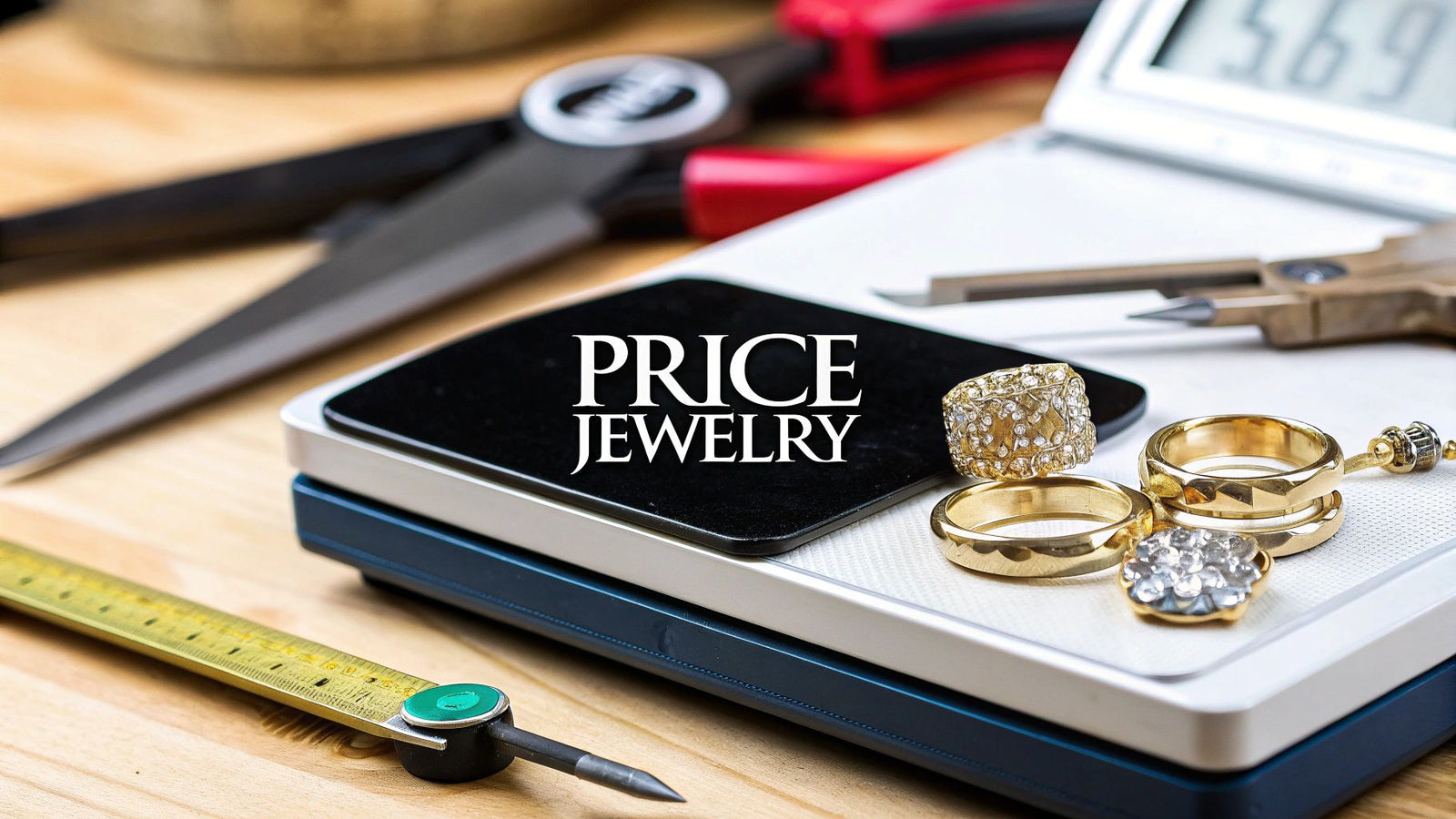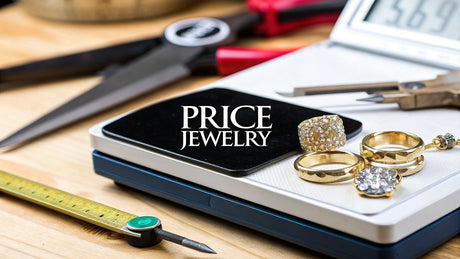Pricing jewelry is part art, part science. It's a delicate balance between the hard costs of materials and labor, and the softer, more subjective elements like market demand and brand recognition. Before you can even think about a markup, you have to nail down the base cost, which starts with a deep dive into the piece's foundational elements—metal purity, gemstone quality, and the craftsmanship that brought it all together.
Understanding What Drives Jewelry Value
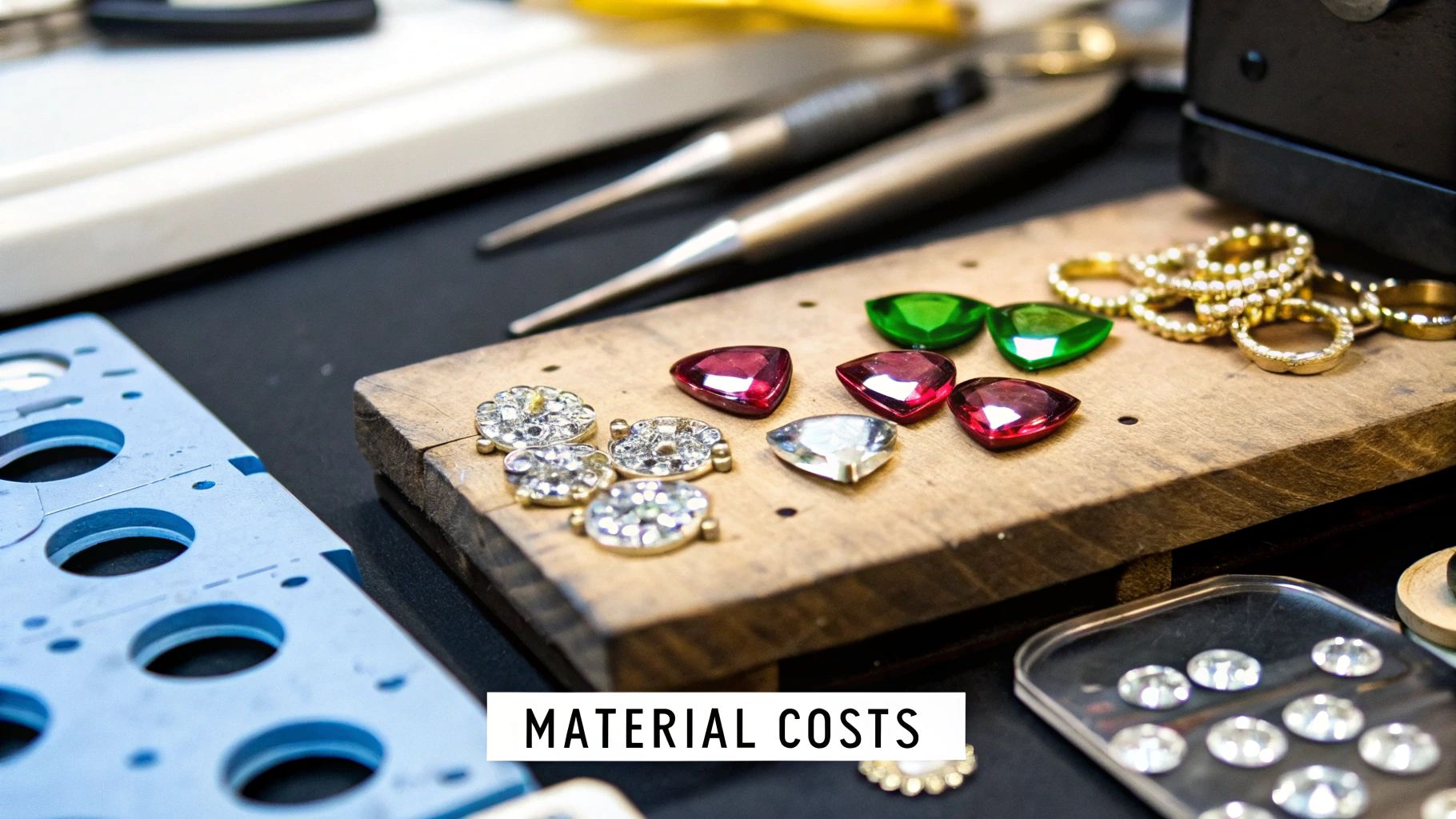
Before you can confidently put a price tag on any piece, you have to truly understand what gives it worth. It’s so much more than just a pretty sparkle. It's a complex blend of tangible and intangible factors that separate a simple gold band from a custom-designed engagement ring, even if they have similar weights.
This foundational knowledge is your first step toward securing the highest payout in Boise. This holds true whether you're an artist selling your own creations or an individual looking to sell a family heirloom. The entire process of gold and jewelry buying hinges on a crystal-clear assessment of these core components.
The Core Components of Worth
Several key elements work together to determine a piece's true market value. Get one of them wrong, and you could be leaving significant money on the table.
- Precious Metal Value: This is your starting point. It’s calculated from the weight and purity (karat) of the gold, platinum, or silver in the piece. Remember, market spot prices change daily, directly impacting this foundational cost. You can learn more about the unique qualities that set some metals apart, like what makes Italian gold so sought after, which often commands a premium.
- Gemstone Quality: If the piece has stones, their value is all about the "Four Cs"—cut, color, clarity, and carat weight. Don't forget that rarity and the stone's origin also play a massive role in its final price.
- Craftsmanship and Design: This is where the human touch adds immense value. Is it a mass-produced item, or is it a one-of-a-kind, handcrafted piece? The skill, time, and artistry invested are crucial. Intricate details and unique designs will always fetch a higher price.
Understanding these elements is absolutely essential. When you're ready to sell, you can save the hassle and sell locally for more than online shipments. A local gold and jewelry buying expert can provide hassle-free offers based on a thorough, transparent evaluation right in front of you.
To simplify, let's break down the main drivers of a jewelry piece's price.
Key Factors Influencing Jewelry Price
This table summarizes the core elements that really determine the final price tag on a piece of jewelry.
| Pricing Factor | What It Means | Example |
|---|---|---|
| Material Cost | The intrinsic value of the metals and gemstones based on current market rates. | The spot price of gold multiplied by the weight and purity of a 14k gold chain. |
| Craftsmanship | The skill, time, and complexity involved in creating the piece. | A hand-engraved filigree pattern versus a simple, machine-cast band. |
| Gemstone Grade | The quality of the stones, determined by the "Four Cs" (Cut, Color, Clarity, Carat). | A flawless, D-color diamond will be exponentially more valuable than a smaller, included stone. |
| Brand & Designer | The reputation and desirability associated with a specific designer or brand name. | A ring from a world-renowned luxury brand versus a non-branded equivalent. |
| Market Demand | Current trends and consumer desire for certain styles, metals, or gemstones. | The high demand for vintage-style engagement rings influencing their market price. |
Each of these factors contributes to the final number, showing how a piece's value is built from multiple layers.
Market Demand and Brand Recognition
Looking beyond the physical attributes, market forces play a huge role. The global jewelry market was valued at approximately USD 232.94 billion in 2024 and is on a significant growth trajectory. This thriving market tells us that demand, current trends, and brand perception heavily influence what a buyer is willing to pay.
For those of us here in Boise, getting an expert opinion that includes services like Xray scanning and gold testing for free can completely demystify the process. Finding a gold and jewelry buying specialist who offers price matching is another great way to ensure you are receiving the best possible local payout for your items.
Calculating Your Material Costs Accurately
Before you can even think about a final price tag, you have to nail down the hard numbers. It all starts with the foundational value of the raw materials themselves. Getting this cost right is the bedrock of any fair price, whether you’re selling a family heirloom or pricing a new piece for your collection.
The process is straightforward but requires precision: determine the weight and purity (karat) of the gold, then measure that against the day’s market spot prices.
Guesswork can cost you, big time. That’s why professional tools aren’t just nice to have; they’re non-negotiable for a true valuation. This is especially true when you’re in the business of gold and jewelry buying, where the tiniest difference in weight or purity can swing the final offer by a surprising amount. Even knowing the value of something unusual can make a difference—you can see what I mean in our guide on how much a gold tooth is worth.
Getting a Precise Measurement
First thing's first: weigh the item. You need a calibrated jeweler's scale for this—the kind that measures in grams, pennyweights (dwt), or troy ounces.
Once you have the weight, the next job is to confirm the metal's purity. A "14k" stamp is a good starting point, but I wouldn't bet the farm on it, especially with older or antique pieces where markings can be worn or even misleading.
This is where professional testing methods come in. For example, right here in Boise, we offer a free, no-obligation Xray scanning and gold testing for free to get a precise reading on the spot. This tech gives us an exact elemental breakdown without leaving a single scratch on the piece, letting us make you hassle-free offers based on solid data, not guesswork. It puts you in the driver's seat, knowing the true raw value of what you have.
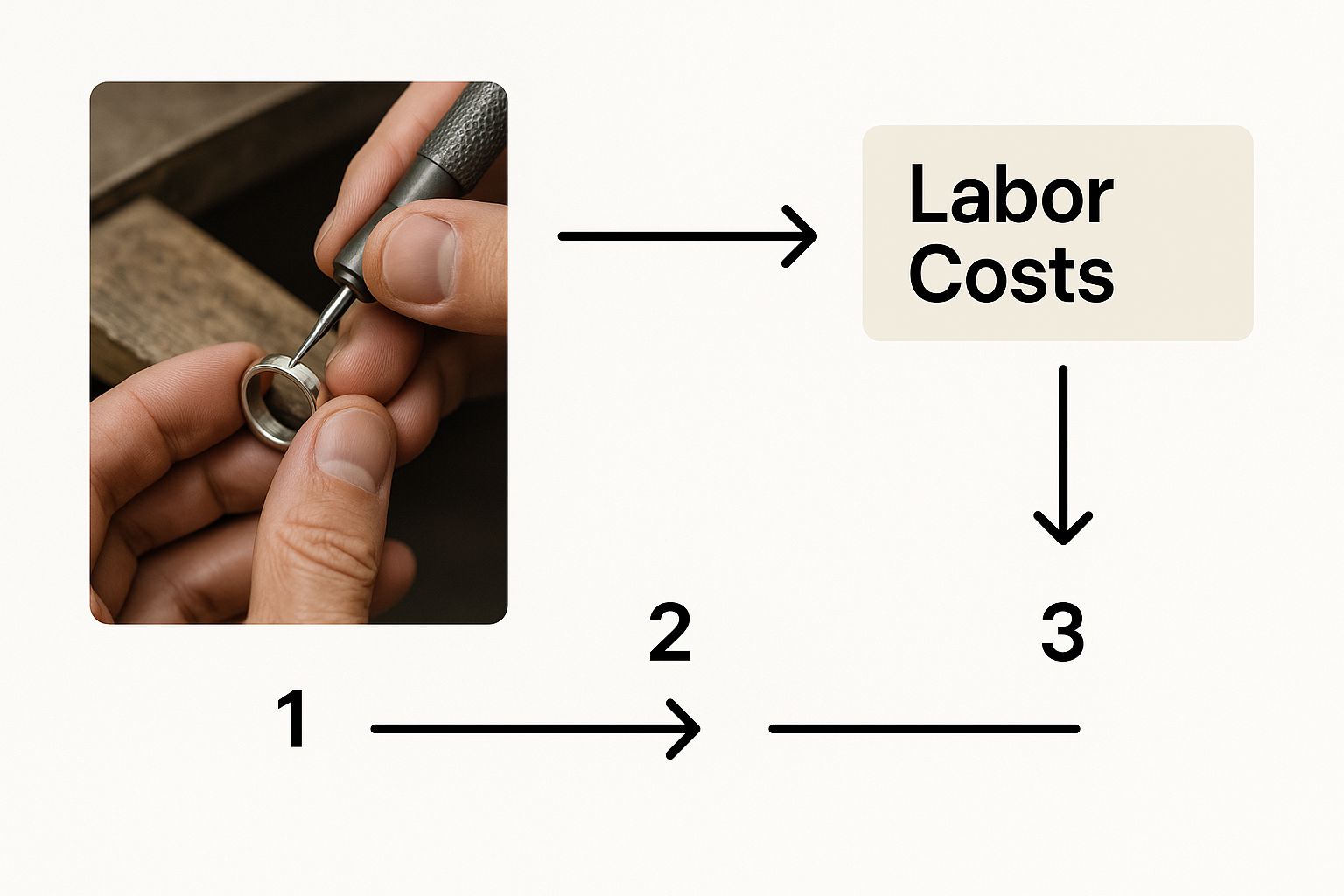
This chart really breaks down how materials and labor come together. As you can see, the metal is a huge part of the equation, but the skill and time involved are just as critical in figuring out a piece's base worth.
From Spot Price to Real Value
With an exact weight and verified purity in hand, you can calculate the "melt value" using the current spot price of the metal. Think of this number as the baseline—the absolute intrinsic worth of your item if it were melted down.
Remember, the material cost is your starting line, not the finish line. It's the absolute minimum value, but it doesn't account for craftsmanship, gemstones, or market demand, which we'll get into next.
By taking these steps, you can confidently pin down your material costs. This is a crucial move if you want to secure the highest payout in Boise. Forget the risk of mailing your valuables off to some faceless online buyer. You can save the hassle and sell locally for more than online shipments.
And once you’ve done your homework, look for gold and jewelry buying experts who offer price matching. It’s the best way to ensure you’re truly getting the top dollar you deserve.
Assigning Value to Craftsmanship and Design
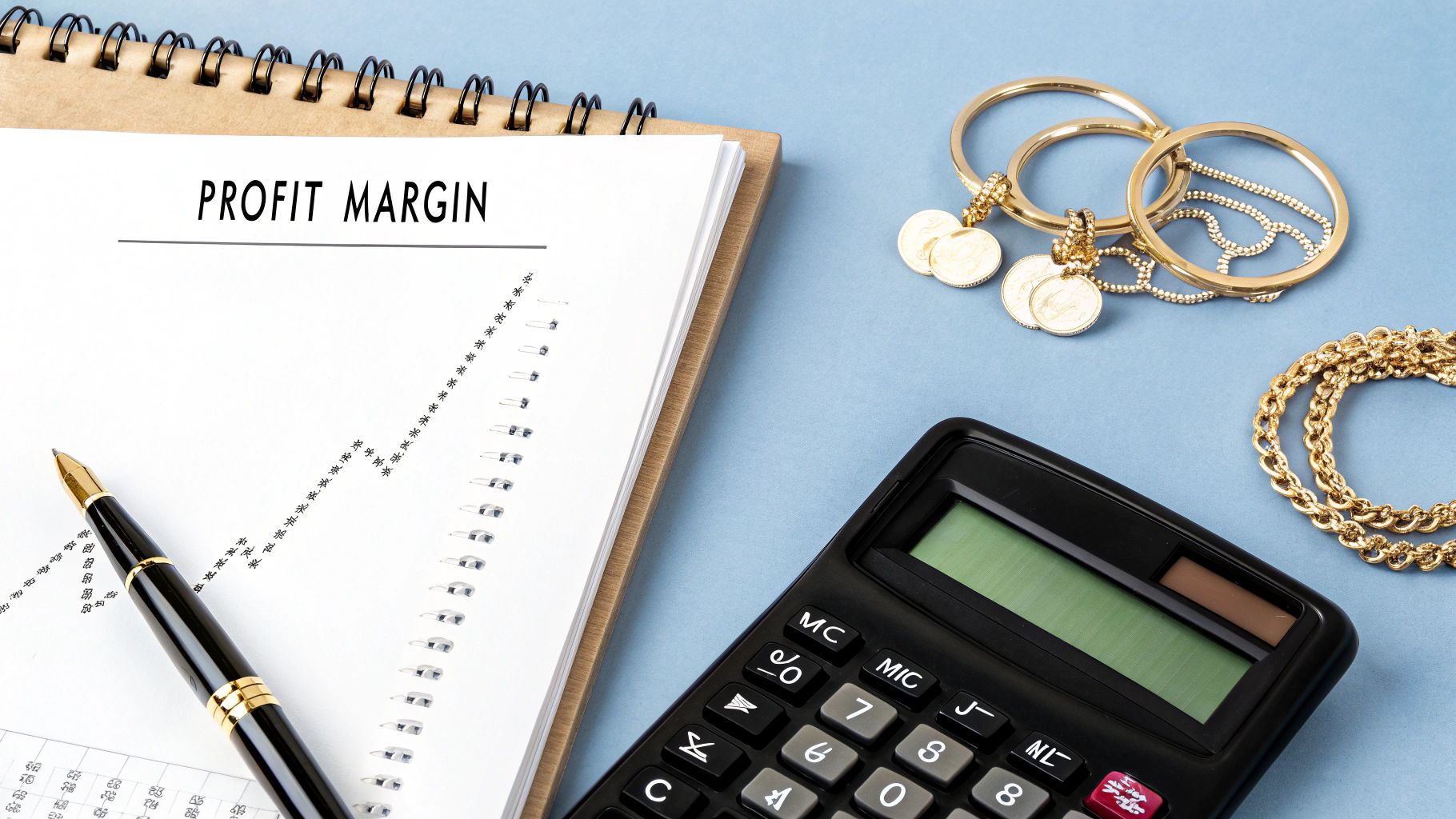
A piece of jewelry is far more than just the sum of its metal and stone; it’s a tiny work of art. The story and value of a piece expand dramatically when you factor in the skill, time, and creative vision poured into its creation.
Understanding this distinction is the key. It's how you accurately price jewelry beyond its raw material worth.
The difference between a mass-produced chain and a handcrafted pendant is immense, and that difference rightfully commands a premium. While both may look appealing, the latter carries the signature of an artist—the subtle imperfections that signify a human touch and a unique design that cannot be perfectly replicated by a machine.
Recognizing Artisan Quality
Assessing craftsmanship means you have to get up close and personal with the details. A high-quality piece will show meticulous attention to its construction.
- Stone Settings: Are the gemstones secure? A skilled artisan ensures each stone is perfectly seated without gaps or loose prongs. This not only protects the stone but actually enhances its brilliance.
- Finishing and Polishing: Look for a uniform, flawless finish. Poor polishing can leave behind tiny scratches or dull spots, detracting from the piece's overall beauty and value.
- Solder Joints: On complex pieces, check where different metal parts are joined. Clean, almost invisible solder joints are a dead giveaway of superior skill.
A common mistake is to view antique or vintage jewelry solely through the lens of its gold weight. In reality, the intricate labor and historical significance often make the piece far more valuable than its melt value alone.
The process of gold and jewelry buying should always account for these artistic elements, especially when you're dealing with unique or antique items.
Accounting for Complex Labor
Certain specialized techniques require years, sometimes decades, of training and add significant value. Think about the delicate precision needed for filigree work, the painstaking process of hand-engraving, or the artistry involved in enamel application.
These are not simple manufacturing steps; they are specialized skills that absolutely contribute to the piece’s final cost.
This is why, when you bring your jewelry for an appraisal, it's about more than just a quick scan. You might wonder if a piece is genuine or simply a well-made replica, which is a valid concern. You can learn how to identify fake gold and other metals to better understand what to look for before getting a professional opinion.
Here in Boise, you can get a free, hassle-free offer that considers both the material and the artistic value. By taking advantage of services like professional Xray scanning and gold testing for free, you get the complete picture.
This helps save the hassle and sell locally for more than online shipments, ensuring you receive the highest payout in Boise. And if you’ve received another quote, don’t forget to ask about price matching to guarantee you’re getting the best possible deal.
Analyzing Market Rates and Competitor Prices
Your jewelry’s price doesn’t exist in a vacuum. After you've figured out its material and artistic value, the real test is seeing where it stands in the current market. Getting competitive and realistic with your pricing means knowing what similar pieces are actually selling for, which sends you on a hunt through everything from sprawling online marketplaces to trusted local jewelry buyers.
It’s easy to feel a bit overwhelmed by all the different places you can sell, but each channel has its own set of pros and cons. The shift to digital has been massive—online jewelry sales are now a huge piece of the puzzle. The global online jewelry market hit about USD 46.1 billion by the end of 2024 and is projected to soar to nearly USD 129 billion by 2032.
This explosive growth shows just how much e-commerce lets sellers tweak their prices, but it also means you’re stepping into a very crowded room. You can discover more insights about online jewelry statistics to get a better handle on this trend.
Exploring Online and Local Markets
The first thing you need to do is look for "comps," or comparable items, to benchmark your piece. A great place to start is online, where a ton of data is right at your fingertips.
- Online Marketplaces: Hop on sites like Etsy, eBay, or even high-end jewelry resellers. These are goldmines for seeing what customers are actually paying for pieces with similar styles, materials, and time periods.
- Retail Jewelers: Don't forget to browse the websites of big chain stores and small independent jewelers. This gives you a sense of their retail markup and helps you understand the top end of the market.
- Auction Results: If you have something truly unique or antique, checking past auction results from houses like Sotheby’s or Christie’s can give you hard data on what serious collectors are willing to pay.
While online research is a great starting point, always remember that a listed price isn't the same as a final sale price. More importantly, selling online is often packed with hidden costs, risks, and lower net returns than a straightforward, local sale.
The Advantages of Selling Locally
Sure, online platforms are convenient, but you will almost always secure a higher payout when you sell face-to-face. This approach lets you save the hassle and sell locally for more than online shipments, completely sidestepping the stress and high insurance costs of mailing precious items.
When you work directly with a gold and jewelry buying expert, you get a transparent evaluation on the spot. For anyone in Idaho, knowing the local Boise market is crucial. A trusted local buyer gives you hassle-free offers based on a physical inspection and precise, professional testing. To get a better feel for your precious metals' value, it helps to understand the factors behind the daily spot price for gold and silver.
Here in Boise, you can take advantage of professional services like Xray scanning and gold testing for free, ensuring you get a dead-on accurate assessment with zero obligation. The best strategy? Find a local expert who offers price matching. This guarantees you receive the absolute highest payout in Boise, giving you the perfect mix of expert market knowledge and the security of a direct, in-person transaction.
Building Your Final Markup Strategy
So, you’ve done the hard work. You’ve calculated your material costs and scouted the market. Now it’s time for the final piece of the puzzle: setting a price that feels right. This is where you move from a simple cost breakdown to a smart retail price—one that ensures you're profitable and truly captures the value of your jewelry.
This isn't about just picking a number out of thin air or slapping a 2x markup on everything. A thoughtful pricing strategy considers your brand, who you're selling to, and the story behind each individual piece. It’s the last, most critical step in learning how to price jewelry like a pro.
Choosing a Pricing Model
There are a few solid ways to approach your markup, and the best one really depends on what you're selling and what your business goals are. Let's break down the most common methods.
You've got your Keystone Pricing (often called Cost-Plus), which is the most straightforward approach. You simply double your total cost—that’s materials, labor, and overhead combined. If a ring costs you $200 to make from start to finish, you'd price it at $400. It's simple, clean, and guarantees your costs are covered. The only downside is that it can seriously undervalue pieces that are exceptionally unique or have a high artistic value.
Then there's Value-Based Pricing. This model is less about hard costs and more about the perceived value to the customer. It takes into account things like brand reputation, the exclusivity of the design, and the level of craftsmanship. An artist with a loyal following can command a much higher price because people aren't just buying gold and gems; they're buying the name and the artistry.
The most effective strategy often blends models. You might use keystone for your basic, everyday pieces while applying a value-based approach to your signature, one-of-a-kind creations to capture their full worth.
This nuanced approach is especially critical when you're dealing with unique or estate pieces. If you're trying to figure out what to do with items from an inheritance, our complete estate sale pricing guide has more specialized advice on that front.
To help you decide which path is right for you, here’s a quick comparison of the most common pricing models jewelers use.
Common Jewelry Pricing Models
| Pricing Model | How It Works | Best For |
|---|---|---|
| Keystone (Cost-Plus) | Double the total cost of production (Cost x 2). | Standardized items, wholesale, ensuring baseline profitability. |
| Triple Keystone | Triple the total cost of production (Cost x 3). | Brands with higher overhead, marketing costs, or a more premium position. |
| Value-Based Pricing | Price is set based on the customer's perceived value of the piece. | One-of-a-kind designs, custom work, and pieces from well-known artists. |
| Market-Based Pricing | Price is set based on what competitors are charging for similar items. | Highly competitive markets with comparable products (e.g., simple gold chains). |
Choosing the right model—or a mix of them—is what separates a good pricing strategy from a great one. Don't be afraid to adapt your approach based on the specific piece you're selling.
Understanding Market Dynamics
The kind of jewelry you’re selling makes a huge difference. You can’t ignore what buyers are actually looking for. For instance, gold jewelry continues to be the heavyweight champion, holding about 54.9% of the global market share in 2024. People love it for its timeless appeal and cultural significance.
When it comes to item types, rings are the clear leader with a 33.8% share of the market, followed by necklaces and earrings. This kind of data is invaluable. It tells you that your pricing needs to reflect not just your costs, but also the real-world demand for certain styles. You can learn more about these jewelry market trends to get a better feel for the landscape.
Finalizing Your Price for a Local Sale
Now, if you're selling jewelry you already own instead of making new pieces, your "markup strategy" is really about making sure you get the best possible offer. Once you have a solid idea of what your item is worth, the final step is finding the right buyer.
This is where local expertise can make all the difference. When you work with a trusted gold and jewelry buying expert right here in Boise, you can save the hassle and sell locally for more than online shipments. You get a transparent, hassle-free offer right on the spot.
Look for a buyer who backs up their valuation with technology, like offering Xray scanning and gold testing for free. To really maximize what you walk away with, always ask if they offer price matching. This commitment is your guarantee that you’re receiving the highest payout in Boise, giving you peace of mind that you got the best price for your valuables.
Got Questions About Pricing Your Jewelry?
When it comes to figuring out what your jewelry is worth, a lot of questions can pop up. It can feel like a complicated world, whether you're a jewelry maker trying to set a fair retail price or just someone hoping to sell a few personal pieces. Let’s cut through some of that confusion and get you the straightforward answers you need.
My goal here is to give you the confidence to make a smart decision, especially if you're looking to turn some of your pre-owned jewelry into cash and walk away with the highest payout in Boise possible.
Is an Appraisal Price the Same as What I Can Sell It For?
This is probably the number one question I hear, and the answer is a hard no. An appraisal value is almost always going to be higher—sometimes much higher—than the actual selling price you'll be offered.
Think of an appraisal as a "replacement value." It’s calculated for insurance companies and reflects the full retail cost to replace your item with a brand-new, similar piece from a high-end store. That number is packed with retail markups. The selling price, on the other hand, is the real-world market value—what someone is actually willing to pay for that piece today.
When you decide to sell, you need to be focused on the fair market value, not the number on your insurance appraisal. A buyer, whether it's a private collector or a professional in gold and jewelry buying, is going to base their offer on the current market price for the materials and how desirable the piece is for resale.
Should I Just Price My Antique Jewelry Based on its Gold Weight?
While the gold content is a critical piece of the puzzle, pricing a beautiful antique piece based only on its melt value would be a massive mistake. Honestly, it's how people leave a lot of money on the table.
True antique jewelry often carries a value far beyond its weight in grams because of its history, the craftsmanship involved, and its rarity. The real value is locked up in its story and artistry. A skilled, experienced buyer will immediately recognize these intangible qualities and factor them in. This is exactly why getting a professional evaluation is so crucial for older items. The gold and jewelry buying process should always respect this artistic value.
Is Selling Online Better Than Selling to a Local Buyer?
It’s tempting to think that online platforms give you access to a huge audience, and they do. But that access often comes with hidden fees, the very real risk of shipping valuable items, and ultimately, a much lower net return than you might expect.
The truth is, you can often save the hassle and sell locally for more than online shipments. A face-to-face transaction with a trusted local expert is transparent. You get to see the process, ask questions, and receive immediate payment without the anxiety of putting your valuables in the mail.
For anyone here in Boise, this is especially true. When you work with a local gold and jewelry buying specialist, you’re getting professional, hassle-free offers from an expert you can actually meet and trust.
How Can I Be Sure I'm Getting the Best Possible Offer?
To guarantee you're getting the top price for your jewelry, it comes down to two things: knowledge and verification. You have to know what you have before you sell. This is where professional services can make all the difference.
You should take advantage of local experts who provide services like Xray scanning and gold testing for free. This kind of non-invasive technology gives you a precise, scientific breakdown of your jewelry’s metal content, completely removing any guesswork from the equation.
Once you have a solid offer in hand, don't be afraid to ask about price matching. A reputable buyer who is confident in their valuation will often match a competitor's written price. This is your final step to guaranteeing you receive the absolute highest payout in Boise and walk away knowing you got the best possible value for your jewelry.
Ready to discover the true value of your jewelry? At Carat 24 - Trusted Gold Experts, we provide transparent, expert evaluations to ensure you receive the highest payout. Visit us in Boise for a free, no-obligation offer and experience the difference of working with a trusted local buyer. Learn more and get your offer today at carat24boise.com.
